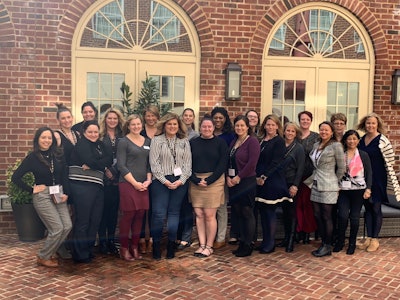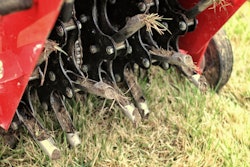 Photo: Beth Hyatt
Photo: Beth HyattThis is part three in a three-part series. Click here to read parts one and two.
At the National Association of Landscape Professionals’ (NALP) recent Workforce Summit in Alexandria, Virginia, Sarah Anderson, senior manager in the Tree Equity Program of American Forests, spoke to green industry professionals about the importance of diversity in the landscaping industry.
Terminology
Along with offering ideas as to how you can work to make your landscaping company a more welcoming place to women and minority groups, Anderson spoke on understanding the difference between terms like diversity/diverse/divergent, equity/equality and more.
“A lot of times, people say, ‘This person is a diverse candidate,’ but one person cannot be diverse,” Anderson says.
When discussing an individual, the proper term to use would be divergent, as this refers to someone who diverges from the norm or typical situation, whereas diverse refers to groups. Diversity, she adds, describes a celebration of differences among a group.
Understanding this terminology can help you greatly when it comes to creating enticing, accurate and informative job descriptions.
“When you’re writing job descriptions and you say diverse candidates are welcome to apply, that’s an okay use of the word diverse,” she says. “But when you say you’ve just hired a diverse candidate, that’s the improper way to use that word.”
When discussing the difference between representation and inclusion, Anderson notes that representation refers to diversity at all levels, while inclusion means that all people in these levels feel valued and feel that they are contributing.
When talking on equity versus equality, Anderson says equality refers to every employee receiving the same treatment and the same opportunities, while equity refers to employees receiving the same treatment and opportunities with respect to where they all individually began, as well as the accommodations they will need to reach those same levels as their co-workers.
The final bit of terminology Anderson spoke on was internal and external accessibility. When talking about internal accessibility, it means there is transparency in accommodations and practices, meaning anyone can file a report or give ideas for new projects/products. When talking about external accessibility, it means there is transparency in policy.
Anderson notes that when referencing accessibility, she isn’t referring to cases where disabled employees are hired, as this would fall under the umbrella of equity and creating appropriate accommodations to ensure every employee is given the same treatment and opportunities.
Recruiting more women
In previous articles, we talked about how veterans often go unnoticed when it comes to searching for qualified labor, but another avenue to explore is the budding possibility of recruiting women into the green industry.
Led by Anderson, roundtable discussions were held to discuss why more women aren’t currently pursuing the green industry and how landscape company owners can make their companies and the jobs more appealing to women.
“Demonstrate how (women) will be included,” says Cari Ciuba with Ruppert Landscape. “I don’t want to be hired just because I’m a female; I want to be hired because you’re actually going to value what I bring to the table. I don’t want to be a checkbox.”
Along with the desire to truly be valued, another suggestion was to work specifically on the language used when placing advertisements for workers. According to Angela Hieronimus with Blade of Green, a program called Textio has proved beneficial in properly preparing advertisements with wording designed to speak directly to women.
“I think sometimes when we’re writing job ads, they’re written from a male’s perspective,” says Hieronimus. “Things like, ‘Work hard, play hard,’ are great for a man, but things like ‘family’ are things that women really care about. Textio can be put in the job ad and it will tell you, in terms of the language you’re using, how likely is it to attract a female. Is it speaking to a feminine crowd as opposed to a masculine crowd?”
Another suggestion was to actively change the everyday wording used when referring to women in the workplace, as well as the mindset associated with hiring and working with women.
“The way that it’s being talked about candidly is sort of like, ‘Hey, I’ve got a woman; she’s tidy, isn’t that great?’” says Patricia Higgins with Chenmark Holdings in Portland, Maine. “There has to be a whole attitude change. You’re talking about finding people and people who can do the job. The more you have this conversation about ‘my woman,’ that language repels capable women. You have to change your attitude and how you’re thinking about stuff.”
Higgins added that it’s important to also take into consideration clothing and uniform options for women when outfitting your crews. Have you purchased clothing that will comfortably and safely fit a woman on your crew, or will she simply be required to wear a smaller size of men’s uniform?
Another major concern from women in the field revolved around access to bathrooms during the day. Many times, women who are on crews will not have access to bathrooms or portable toilets throughout the day, which drives them to feel unimportant, not provided for and unable to work efficiently and to the best of their abilities.
Along those same lines, it’s important to make sure you as the employer are offering policies that help and promote women, such as specific healthcare options, maternity leave, childcare and tools and hardhats specifically designed to be used by women.
In order for women to feel more valued and included in this industry, Higgins says we have to stop looking at the situation as, “I have my token woman.”
“One huge problem I ran into when I first got into this industry was the hours that you were expected to work in a week, especially since I was getting older and thinking about starting a family,” says Caitlyn Clineff, recruiting specialist and company ambassador for Myatt Landscaping Concepts. “I couldn’t see myself continuing to work 60-70 hours a week with no overtime and think about starting a family.”
Clineff says if more companies would consider implementing shift-based crew work or allowing crew members to only work a certain number of hours in a day, this could potentially help attract more women to the field.
According to Anderson, this can easily be achieved by standardizing and formalizing accommodations into a policy when the individual is hired to show you value these new hires as whole people. This, she says, falls under the category of equity.
“There’s two energies in the world: do and be,” says Anderson. “We live in a society that glorifies ‘do’ energy. What’s been done, what’s going to get done, what are you doing, etc. A lot of people balance that during the day and channel that ‘be’ energy when they get home and defer to that feminine energy. We actually need that feminine energy outside in the world now to be successful. (Women are) in touch with how people are, and we are closer to true emotions. Those things are not recognized, valued and appreciated yet in the work setting.”
Anderson agrees that the language used to describe women in the green industry needs to change, as well as how women process emotions is viewed. It’s important to create spaces in the workforce that value the emotional intelligence of a woman, she says, instead of simply writing it off as them being angry or “too emotional.”
On a final note, it was agreed upon that more needs to be done to market this industry to younger women in middle, high school and college. Many women in the green industry, like Katie Harper with Davey Tree Expert, stumbled into the industry in college but were never directly told they could make a thriving and fulfilling career out of it.
“My male peers knew about the industry; this was sold to them as a possibility,” she says. “But that was not sold to me as a young woman. As you interact with young women and children, don’t walk up to a little girl and ask her, ‘You look so pretty. What’s your favorite dress?’ Ask her what she likes to do. Ask her if she likes to work outside. Make sure we’re marketing this as an opportunity for everybody. This industry’s not for every man, as it’s not for every woman. We don’t want just anybody; we want the best.”











